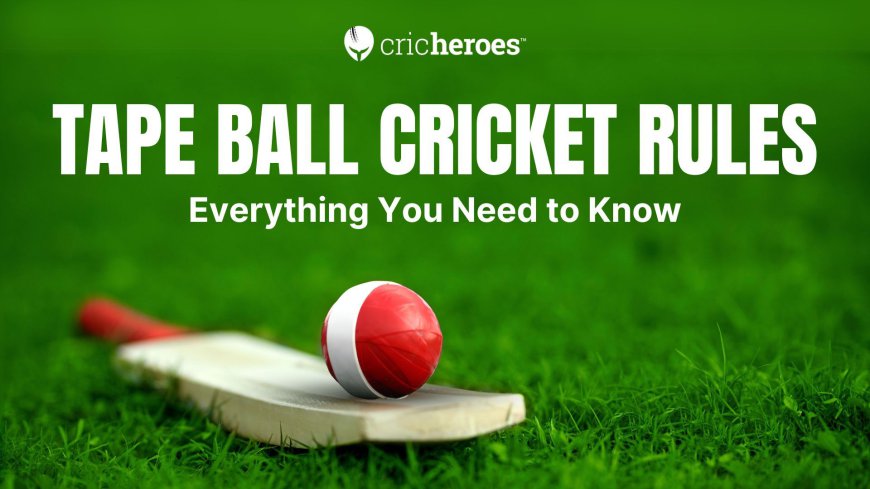Everything You Need to Know About Tape Ball Cricket Rules
Learn everything about tape ball cricket rules, from equipment and gameplay to scoring. Discover how to enjoy this exciting and easy-to-play format!

Cricket is loved worldwide, but not everyone has access to professional equipment or fields. That’s where tape ball cricket steps in! This unique version of the game brings all the excitement of cricket to the streets, parks, and backyards, offering a simpler and more accessible way to play. Let’s break down the essential tape ball cricket rules to help you understand how it works and how you can join the fun.
What is Tape Ball Cricket?
Tape ball cricket is a casual version of cricket played using a tennis ball wrapped in electrical tape. The taped ball provides a balanced mix of speed and bounce, making it ideal for recreational games. Originating in Pakistan, it has spread across the globe, becoming a favorite pastime for players of all skill levels.
Why Play Tape Ball Cricket?
- Affordability: Minimal equipment is required.
- Convenience: It can be played almost anywhere.
- Inclusivity: Great for beginners and pros alike.
- Flexibility: Rules are adjustable to fit the situation.
Basic Equipment for Tape Ball Cricket
You don't need a lot to get started. Here’s a quick list:
- Tape Ball: A tennis ball wrapped in electrical tape.
- Bat: A regular cricket bat or a lighter wooden bat.
- Wickets: Stumps, chairs, or any makeshift item to act as the target.
- Ground: Any open space can work, from streets to parks.
Also Read : The Rise of Tape ball Cricket
Essential Tape Ball Cricket Rules
1. Team Composition
- Each team typically has 6–8 players.
- Smaller teams make the game faster and more engaging.
2. Match Duration
- Matches are shorter, with each inning lasting 5 to 10 overs.
- This keeps the game quick and entertaining.
3. Bowling Rules
- Bowlers must deliver underarm or overarm, depending on mutual agreement.
- No bouncers are allowed, as the taped ball doesn’t handle excessive bounce well.
4. Batting Rules
- Batsmen can be “out” in various ways: bowled, caught, or run out.
- LBW (Leg Before Wicket) is generally excluded in casual settings.
5. Fielding Rules
- Fielding restrictions are minimal, allowing freedom of positioning.
- A common rule is “one-tip out,” meaning a single bounce before a catch is still considered out.
6. Scoring
- Boundary rules are the same as standard cricket: 4 runs for a grounded hit, 6 runs for a shot over the boundary.
- Runs are scored by running between wickets or hitting boundaries.
Special Variations in Tape Ball Cricket
1. Powerplay Overs
- Teams can designate 1 or 2 overs as powerplay overs, where fielding restrictions apply.
- This makes scoring easier and adds excitement.
2. Fixed Bowling End
- To simplify the game, all deliveries may be bowled from one end.
- This reduces confusion, especially in tight spaces.
3. Penalty for Losing the Ball
- In neighborhood games, losing the ball may result in a penalty, such as a deduction of runs.
Top Strategies for Success
For Batsmen:
- Timing Over Power: Since the ball is lighter, timing your shots is crucial.
- Placement Wins: Look for gaps in the field to maximize runs.
- Adapt to Bounce: The ball bounces differently, so stay ready.
For Bowlers:
- Vary Your Pace: Keep batsmen guessing by changing speeds.
- Use Angles: Deliver from different angles to confuse the batter.
- Target the Stumps: Focus on accurate deliveries to increase chances of a wicket.
For Fielders:
- Stay Alert: With shorter boundaries, quick reactions are critical.
- Backup Always: Be ready to cover for misfields.
Common Penalties in Tape Ball Cricket
- Overstepping the Crease: Results in a no-ball.
- Time Wasting: Umpires can penalize teams delaying the game.
- Unfair Bowling Action: May lead to disqualification of the bowler.
Benefits of Playing Tape Ball Cricket
- Improves Reflexes: The lightweight ball requires quick reactions.
- Enhances Teamwork: Players must coordinate closely.
- Encourages Fitness: Offers a fun way to stay active.
- Builds Community: Brings friends and family together for enjoyable matches.
Tape Ball Cricket Around the World
This form of cricket is particularly popular in South Asia but has gained traction in other regions as well. Many countries host informal tape ball tournaments, showcasing its global appeal.
FAQs About Tape Ball Cricket
1. What is the ideal size of a tape ball cricket field?
The size can vary, but typically a smaller field is used, measuring around 30–40 meters in diameter.
2. Why is tape used on the ball?
The tape provides weight, reduces wear, and improves the bounce and speed of the ball.
3. Can professional cricketers play tape ball cricket?
Yes, many professionals enjoy tape ball cricket during off-seasons for practice and fun.
4. How are umpires decided in tape ball cricket?
In casual games, players often rotate as umpires. In tournaments, neutral umpires are assigned.
5. Will tape ball cricket damage my cricket bat?
Not significantly, as the ball is lighter. However, using a dedicated bat for tape ball cricket is recommended.
Conclusion
Tape ball cricket is more than just a game—it’s a celebration of cricket’s spirit. With its flexible rules, minimal equipment, and universal appeal, it’s perfect for players of all levels. Whether you’re a beginner or an experienced cricketer, tape ball cricket offers a fun and exciting way to enjoy the game anytime, anywhere.
